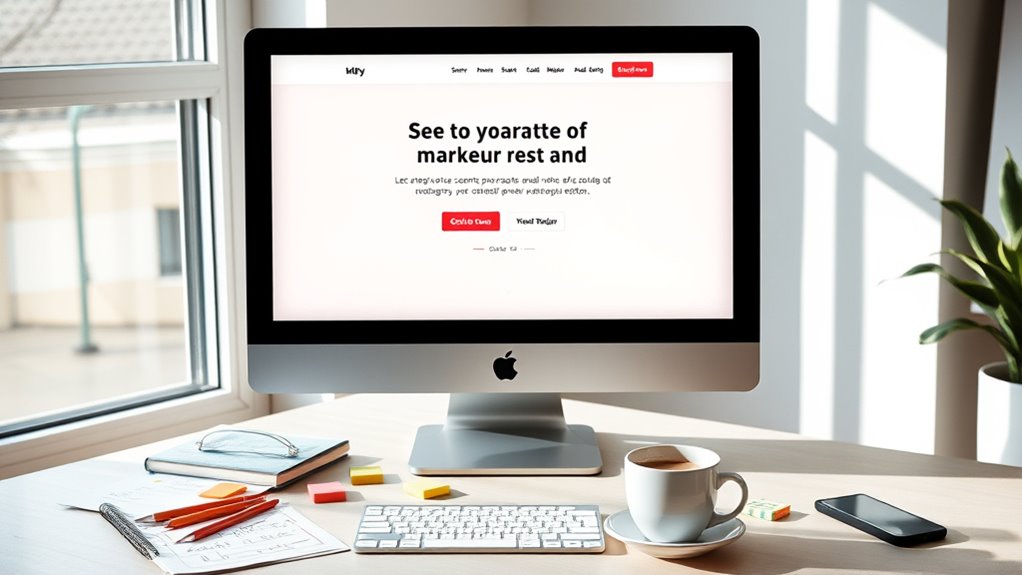To build sales funnels that sell, you need landing pages that connect with your audience’s psychology. Use persuasive headlines, benefit-driven copy, and social proof to build trust quickly. Keep your design clean and focused, with clear calls to action that create urgency. Personalize content and test different elements to optimize conversions. When these strategies work together, you’ll create compelling pages that guide visitors effortlessly toward action, revealing even more effective techniques along the way.
Key Takeaways
- Craft persuasive headlines and benefit-driven copy that immediately address visitors’ needs and emotions.
- Use social proof like testimonials and case studies to build trust and credibility.
- Design clean, focused landing pages with clear CTAs and strategic visual contrast to guide conversions.
- Personalize content and dynamically tailor experiences based on user behavior and browsing history.
- Continuously test and optimize elements such as headlines, images, and placement to improve performance.

Are you ready to turn prospects into loyal customers? Building effective sales funnels starts with understanding customer psychology and applying targeted conversion tactics. When someone visits your landing page, they’re looking for a solution to a problem or a desire. Your job is to tap into their mindset, make an immediate connection, and guide them toward taking action. Customer psychology plays a critical role here; you need to appeal to their emotions, fears, and motivations. By aligning your messaging with what really matters to your audience, you create a compelling reason for them to stay and engage.
Conversion tactics are the tools you use to turn curiosity into commitment. Clear, persuasive headlines grab attention instantly, making it obvious what benefit they’ll get. Use concise, benefit-driven copy that emphasizes how your offer solves a problem or improves their life. Break down complex ideas into simple, digestible points. Incorporate social proof, such as testimonials or case studies, to build trust and credibility. When visitors see others have benefited from your product, their confidence in your offer increases, making them more likely to convert.
Design matters just as much as content. A clean, uncluttered landing page focused on a single call-to-action (CTA) minimizes distractions. Use contrasting colors and strategic placement to draw attention to your CTA button. Phrases like “Get Started Now” or “Claim Your Discount” create urgency and motivate immediate action. Personalization can also boost conversions; address users directly and tailor content based on their behaviors or interests. For instance, dynamic content that reflects their browsing history or preferences can make your offer seem more relevant and appealing.
Testing different elements is essential. A/B testing headlines, images, CTA placements, and copy allows you to discover what resonates best with your audience. Pay attention to analytics—bounce rates, click-through rates, and conversions—to constantly refine your approach. Remember, building a landing page isn’t a one-and-done task; it’s an ongoing process of optimization based on customer insights and data. Additionally, understanding the contrast ratio of your visuals can significantly enhance perceived image quality and viewer engagement.
Ultimately, your goal is to create a seamless experience that aligns with customer psychology and uses smart conversion tactics. When done right, your landing page guides visitors effortlessly through your sales funnel, turning initial interest into a committed customer. Focus on clarity, relevance, and persuasion, and you’ll see your conversion rates climb. Every element should work together to build trust, spark interest, and prompt action—because the more effectively you understand your prospects and cater to their needs, the more successful your sales funnel will become.
Frequently Asked Questions
How Do I Optimize Funnels for Mobile Users?
To optimize funnels for mobile users, focus on responsive design that adapts seamlessly to different screens. Keep your layout simple, with clear calls-to-action and minimal text to enhance mobile optimization. Test your funnels on various devices to identify and fix any issues. Prioritize fast loading times and easy navigation. By doing so, you guarantee your mobile visitors have a smooth experience, increasing conversions and engagement.
What Are Common Mistakes to Avoid in Landing Page Design?
Think of your landing page as a well-tuned orchestra. Avoid clutter that distracts from your message, and guarantee your visual hierarchy guides visitors smoothly. Don’t ignore color psychology—use it to evoke emotion and boost conversions. Failing to keep the design simple, neglecting mobile responsiveness, or overloading pages with too much info are common mistakes. You want harmony, not chaos, to lead visitors effortlessly toward action.
How Can I Track Funnel Performance Effectively?
To track funnel performance effectively, you should focus on analytics tracking and conversion metrics. Set up tools like Google Analytics or dedicated funnel software to monitor user behavior at each stage. Regularly review data on click-through rates, bounce rates, and conversions. This helps you identify drop-off points and optimize your landing pages accordingly, ensuring your funnel performs at its best and drives more sales.
Which Tools Are Best for Creating High-Converting Landing Pages?
Did you know that A/B testing can improve conversion rates by up to 49%? For creating high-converting landing pages, you should use tools like Unbounce, Leadpages, or Instapage. These platforms make it easy to test different designs, headlines, and calls-to-action. Incorporate color psychology to evoke emotions and guide visitors’ decisions. Choose tools that offer built-in A/B testing features and customizable templates to optimize your landing pages effectively.
How Do I Personalize Funnels for Different Audience Segments?
To personalize funnels for different audience segments, start with segmentation strategies that divide your audience based on demographics, behaviors, or preferences. Use personalized content to address each segment’s unique needs and pain points, making your messaging more relevant. Continuously analyze performance data to refine your approach, ensuring your funnel resonates with each group and increases conversions. This targeted approach boosts engagement and drives better results.
Conclusion
Now that you know the essential landing page strategies, you’re ready to build sales funnels that convert. Remember, businesses that optimize their landing pages see up to a 50% increase in leads. By applying these tactics, you’ll guide visitors smoothly toward taking action. Keep testing and refining your approach, and watch your conversions grow. Start implementing today, and turn your landing pages into powerful sales tools that truly sell!








